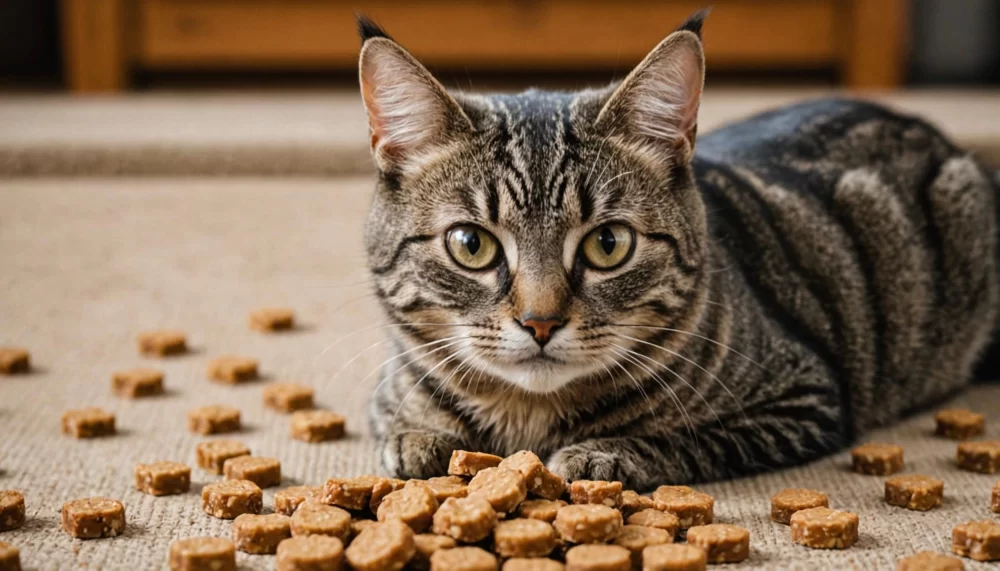- Understanding-Diabetes-in-Cats
- Importance-of-Special-Diets-for-Diabetic-Cats
- Creating-Homemade-Treats-for-Diabetic-Cats
- Case-Studies-Showing-Benefits-of-Special-Diets
- Professional-Advice-for-Managing-Cat-Diabetes
1. Understanding Diabetes in Cats
Diabetes mellitus is a common and serious condition in cats, caused by the body's inability to produce or properly use insulin. This results in elevated blood glucose levels that, if left unmanaged, can lead to severe health problems including weight loss, increased thirst, and lethargy.
Recognizing the symptoms early is critical for effective management. Beyond medication, diet plays a pivotal role in stabilizing blood sugar and improving a diabetic cat’s quality of life. Many cat owners find themselves searching for homemade treats for diabetic cats that fit into these dietary needs without sacrificing flavor or enjoyment.
The Role of Nutrition in Diabetes Management
Nutrition impacts how well insulin works and how glucose is regulated. A balanced diet designed specifically for diabetic cats usually involves controlling carbohydrate intake while ensuring sufficient protein and fat to maintain energy levels and muscle mass.

885 Canarios Ct Suite 108, Chula Vista, CA 91910, USA
See Details2. Importance of Special Diets for Diabetic Cats
Special diets formulated for diabetic cats are carefully balanced to support blood sugar regulation. These diets typically feature low carbohydrates and high protein content, which is markedly different from the diets of healthy cats.
Why Special Diets Matter
Cats are obligate carnivores, meaning their systems thrive on protein-rich foods. For diabetic cats, diets with moderate fats and minimal carbohydrates help prevent spikes in blood sugar, reduce insulin resistance, and support overall metabolic health. Special diets also often contain added nutrients such as fiber and antioxidants to improve digestion and immune function.
Challenges with Commercial Options
While many commercial diabetic cat foods exist, they may not suit every cat’s preferences or specific health needs. This is why some cat owners turn to making homemade treats for diabetic cats and adapting special diets in ways that are both safe and palatable.
3. Creating Homemade Treats for Diabetic Cats
Making homemade treats for diabetic cats requires careful ingredient selection and preparation methods to ensure safety and nutritional balance. Here are key principles to keep in mind:
Choosing the Right Ingredients
Lean proteins such as cooked chicken, turkey, or fish form the foundation. Avoiding sugars and starches is essential, so ingredients like grains, corn, or potatoes should be excluded. Instead, small amounts of cat-safe vegetables such as steamed pumpkin or green beans can add fiber and texture.
Simple Treat Recipes
A popular recipe includes finely shredded chicken mixed with a small amount of pureed pumpkin, formed into small bite-sized pieces and gently baked. This combination supports blood sugar stability and provides a flavorful snack your cat will enjoy.
Portion Control and Frequency
Even treats need to be given in moderation. Overfeeding can disrupt blood sugar balance, so treat portions should be small and incorporated within the daily calorie and carbohydrate limits set by your veterinarian.
4. Case Studies Showing Benefits of Special Diets
Consider Lucy, a 10-year-old domestic shorthair diagnosed with diabetes. Her owner switched to a homemade treat routine alongside a special diet recommended by their vet. Within weeks, Lucy’s blood glucose levels stabilized, and she regained her playful energy. The homemade treats made it easier to reward her without risking glucose spikes.
Another example is Simba, whose owners struggled with his lack of appetite on commercial diabetic diets. Custom-made treats featuring boiled turkey and pumpkin rekindled Simba’s enthusiasm for food and improved his overall health metrics, including a reduction in insulin requirements.
These cases illustrate that homemade treats tailored to diabetic needs, combined with special diets, can significantly improve management outcomes and enhance a cat’s happiness.
5. Professional Advice for Managing Cat Diabetes
Managing diabetes in cats is complex and requires a multi-faceted approach. Beyond diet and treats, regular veterinary check-ups and monitoring are essential.
Regular Monitoring and Vet Guidance
Frequent blood glucose monitoring helps track how diet adjustments affect your cat’s condition. Vets can provide personalized advice on treat recipes and special diets tailored to your cat’s unique health profile.
Utilizing Trusted Resources
For expert guidance, products, and recipe ideas specifically designed for diabetic cats and special diets, Hidden Brook Veterinary offers trusted support and quality options that prioritize your cat’s well-being.
Patience and Consistency
Success in managing feline diabetes through diet requires patience. Consistent feeding schedules, measured treats, and ongoing communication with veterinary professionals will make a tangible difference in your cat’s health journey.
By thoughtfully creating homemade treats for diabetic cats and embracing specialized diets, you empower yourself to take a proactive role in your cat’s diabetes care, enhancing their comfort, longevity, and joy.











